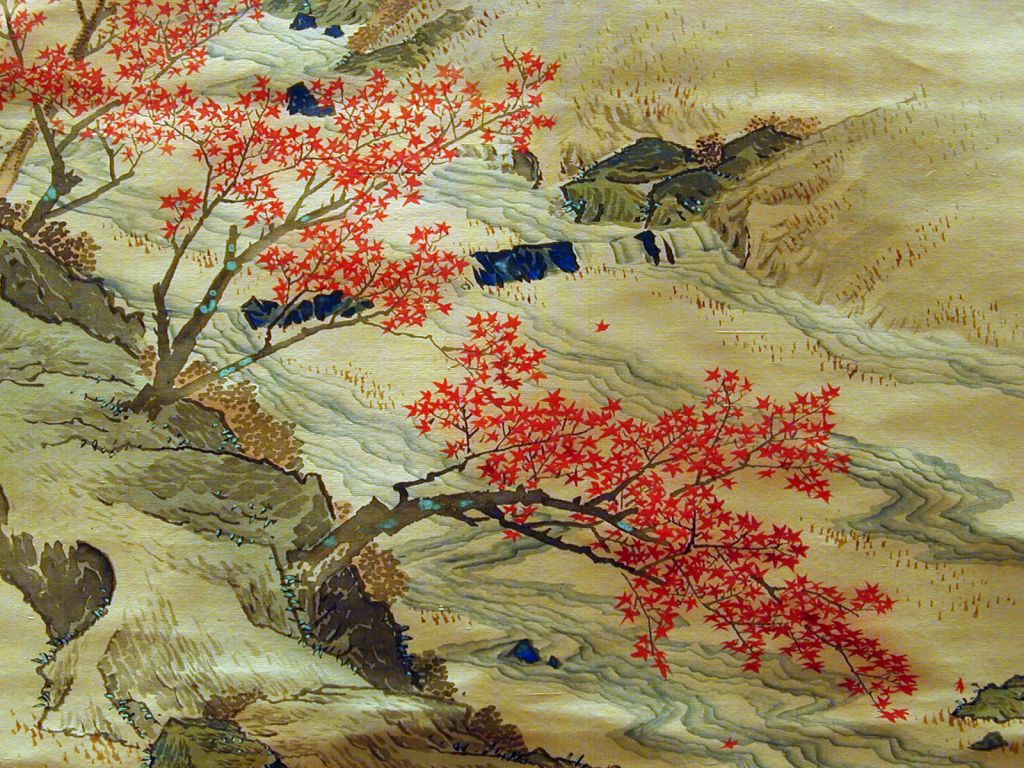Pick up almost any book about East Asian – Chinese, Japanese, and Korean – painting, and once it gets to about 1800 it grinds to a halt, as if that was the end of art. In the case of print-making in Japan, you will see plenty about ukiyo-e such as the famous prints by Hokusai. But finding images of paintings made at that time in Japan is far harder.
Dig deeper and you will find a little information that reveals that Japanese painting, in particular, underwent major changes during the nineteenth and early twentieth centuries, as it evolved from traditional ‘pre-Renaissance’ styles to those more comparable with Western painting. In effect, it underwent the changes seen in Europe during the Renaissance, going from tightly-prescribed traditional forms created under a complex and ancient set of rules, to the depiction of surface texture, shadows, optical effects, and depth.
I stumbled across this when I was researching Japanese Impressionists for my earlier article. Instead of the massive literature about the Western Renaissance, similar changes when they took place in East Asia have almost been ignored by both Western and Eastern art historians.
The great James Elkins wrote this about the gap in the history of Chinese painting, specifically as it appears in the German Propyläen Kunstgeschichte, a massive and authoritative history of art:
“It is impossible, I think, to overestimate the oddity of this elision. Its precise parallel in the West would be a four-hundred-page volume on European art with two pages on painting since Jacques-Louis David, culminating in a single, intensely derogatory sentence on the art of the last hundred years.” (Elkins 2010, p 102.)
Similarly, the late and very great Harrie A Vanderstappen’s wonderful book The Landscape Painting of China (2014) contains no work more recent than 1705, a pattern which is repeated through many other books published in the West.
Much as I would have liked to cover Chinese, Japanese and Korean painting during this period, I have found it challenging enough to tackle painting in Japan. So this (short) series of articles will try to explain what happened to transform Japanese painting from traditional to modern forms.
As ever, I will try to illustrate its stages with appropriate examples; these have been hard to come by, and I am afraid that some important works are only available at quite low resolutions. However I will do my best to ensure that the series is well illustrated throughout.
Let me also make it clear that I do not consider realist or Western (洋画 yōga) style art any superior to traditional East Asian including 日本画 nihonga) style art: there are many outstanding masterpieces in each style. What is most important is the freedom for an artist to choose the style which is most suited to their subject, public, and purpose.
What changed?
Before Japanese painters started to become influenced by Western painting, the great majority of their paintings were made using suspensions of pigment or dye in water with animal glue as binder (effectively what in the West would be termed distemper or tischlein), applied to flexible grounds such as silk and paper, using brushes and pens of various types. Although traditional Japanese paints are sometimes referred to as being watercolour or gouache, they do not use the same binder as Western watercolour or gouache, which are based on plant-derived gum arabic rather than animal glue.
With strong Chinese influence, Japanese paintings usually had explicitly formed outlines containing flat areas of even colour. Skies were often ignored completely, or painted very simply. A limited range of techniques was used to indicate depth, including depth order, position in the picture space, and relative size (although that was often understated). Texture, shading and shadow were seldom shown, aerial perspective limited (marked in some paintings), and projections used were quite different from those of linear perspective. Indeed, some modern critics of linear perspective cite traditional East Asian painting as an example of successful painting which did not use linear perspective.
There were thus many parallels between traditional Japanese painting and that in Europe prior to the Renaissance.
There had of course been substantial changes in style which had taken place over the course of the history of painting in Japan.

By the late Muromachi period, painting had moved out of the monasteries, and Kanō Masanobu (狩野 正信) (c 1434-1530) founded the Kanō school, which was to remain dominant for the following four centuries, until the Meiji period. His Zhou Maoshu Appreciating Lotuses (周茂叔愛蓮図 (しゅうもしゅくあいれんず)) (Muromachi, 1400s) is typical of what many people would consider to be classical Japanese painting.

Kanō Hideyori’s (d 1557), Maple Viewers (紙本著色観楓図) (Muromachi, early 1500s) shows much more extensive use of colour, but still the classical style of the Kanō school. Note how each motif incorporated into the painting is carefully separated using a mist or cloud bank, a popular device.
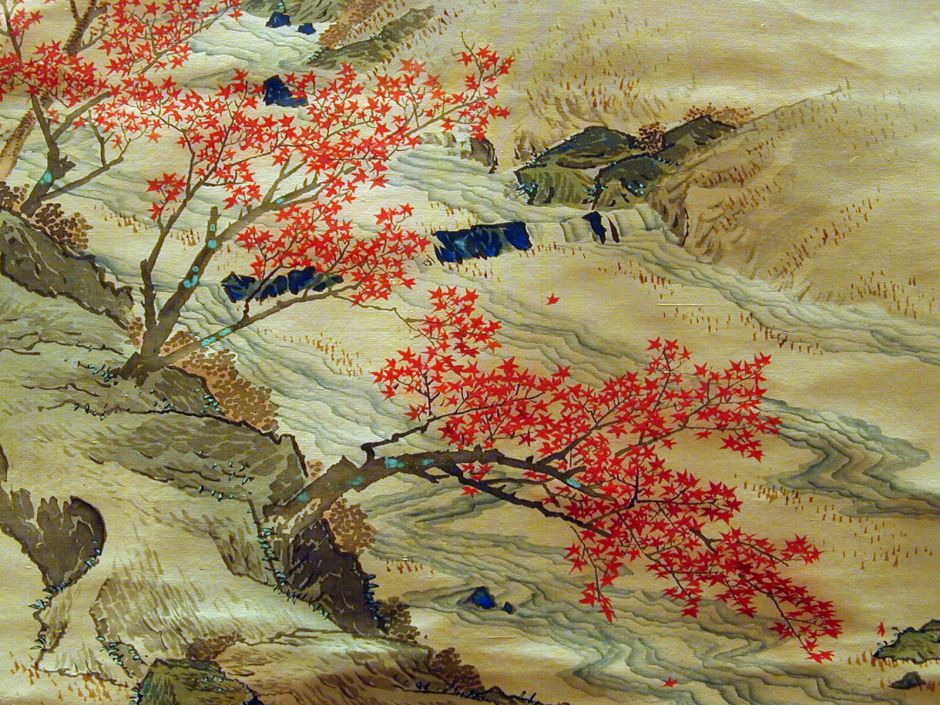
Maruyama Ōkyo (円山 応挙 or 圓山 應舉) (1733-1795) studied art from China and Western sources when he trained in Kyoto, leading him to found the realist Maruyama school of painting. Although his The Journey of Narihira to the East (Edo, 1780) was painted using traditional ink and colours on silk, it has features which are much closer to those of Western watercolours. However he still used formed outlines, foliage is more symbolic than actual, shadows are largely absent, and the water surface is depicted more symbolically.
Other artists and critics of the day disapproved of this realist style, saying that it was too concerned with physical appearances, but it proved commercially successful. It has also been claimed that Ōkyo was the first Japanese painter to draw nude models from life, although he did not paint nudes and it would be more than a century before the first nude painting went on display in Japan.

Although the Meiji marked great change, traditional painting did not disappear. Indeed more conservative painters such as Hidaka Tetsuō (1791-1871) retained much older style in works such as Snowy Landscape (Meiji, 1869).

Hagura Katei’s (1799-1887) Elegant Gathering in the Western Garden (Meji, 1882) is another example of this late flowering of what remains in essence the Kanō school.
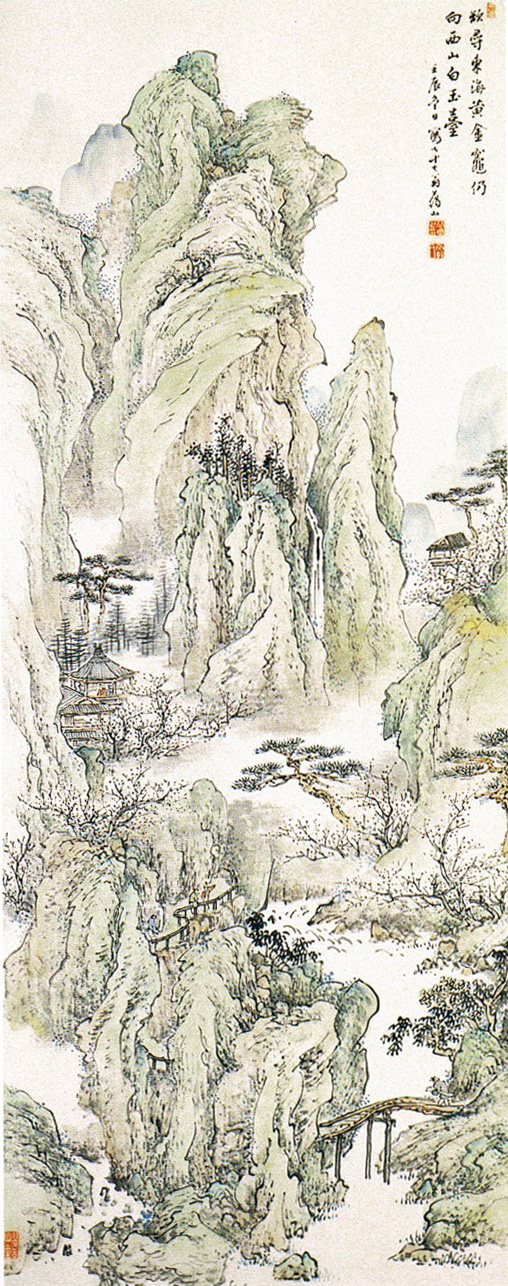
There were others who started to develop traditional painting in new directions, such as Taniguchi Aizan (谷口愛山) (1816-99) in his Landscape (Meiji, 1892).

Tanomura Chokunyū (1814-1907) was another member of the Nanga school who kept this ‘literati’ (or Bunjinga) genre going long after the end of the Edo period. His Great View of Mountain and River (Meji, 1896) shows considerable influence from Chinese style too.
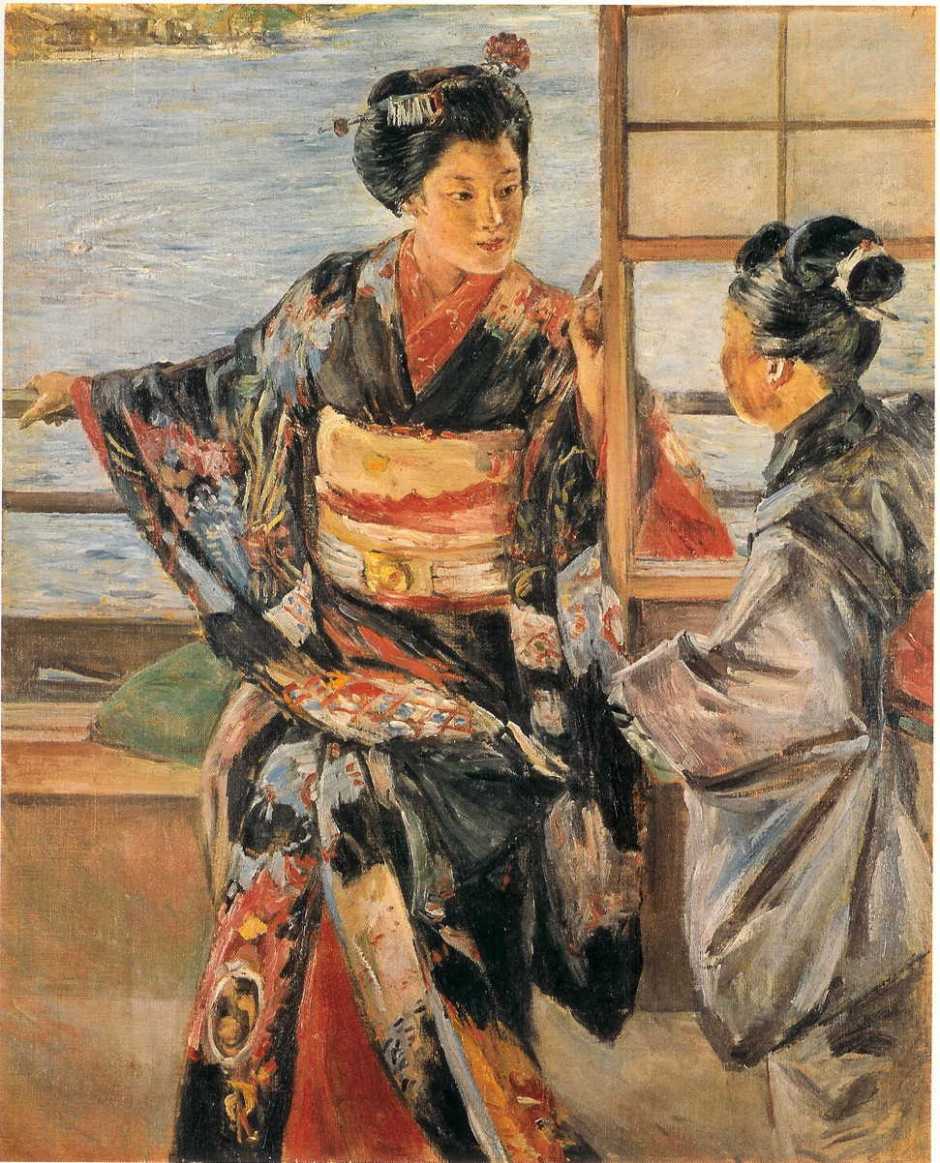
At the same time, painters such as Kuroda Seiki (黒田 清輝) were returning from their training in France, and using oil paints on canvas supports to create distinctive Western-style paintings such as this, his outstanding Maiko Girl (舞妓) (1893). Ultimately by the early twentieth century, many Japanese painters had adopted Western techniques and styles, although there remained a strong school of traditional painting too.

Fujishima Takeji (藤島 武二) (1867-1943) was a protege of Kuroda Seiki, a member of his Hakubakai art group, and from 1905 studied at the École Nationale Supérieure des Beaux-Arts in Paris, under Fernand Cormon. He went on to study portraiture under Carolus-Duran (who taught John Singer Sargent) at the French Academy in Rome. His Distant View of Awajishima (淡路島遠望) (Shōwa, 1929) is a good example of the ultimate Westernisation of painting in Japan, with its international style.
Outside influence
East Asia became connected by trade routes, the Silk Road in particular, in the last couple of centuries BC. These flourished during Roman times, but with the collapse of the Roman Empire, communications lapsed until around 640 CE. A few notable individuals travelled the route during the stable period of the Mongol Empire during 1207-1360, including the Venetian Marco Polo, who famously wrote about his experiences.
After the Mongol Empire collapsed, European states sought a sea route to East Asia, which was achieved by 1500 with the expeditions of Bartolomeu Dias and Vasco da Gama. Interestingly this was also the motive for the journey in which Christopher Columbus discovered the Americas in 1492. As a result of this campaign to establish trade by sea, exchange of goods was restored with China in 1513, and Portugal gained the colony of Macao in 1557, when it was handed to them by the Emperor of China.
Although Japan, China and Korea had sustained trade and cultural exchange since the dawn of history, the first Europeans did not set foot in Japan until 1543. There was then a rapid development of trade, with Europeans selling muskets to arm the daimyo lords during the period of political instability at the end of the Muromachi period in Japan. Christian missionaries were also very active, led by the Jesuit Francis Xavier, who arrived in 1549, and converted substantial numbers to Christianity.
For almost a century, during a turbulent period of politics known as the Azuchi-Momoyama period, European trade and the spread of Christianity were accepted in Japan. However, in 1600 (the start of the Edo period), victory in the crucial battle of Sekigahara by Tokugawa Ieyasu established him as the Shōgun, (de facto ruler) and Western influence was gradually suppressed.
A policy of isolation (known as sakoku) prevailed after an unsuccessful Christian-led rebellion in 1638. As a result Japanese people were forbidden from travelling abroad, and the only trading post permitted was a delimited island in the bay of Nagasaki, in the extreme south-west of the Japanese archipelago. That was maintained by Dutch merchants working for the Dutch East India Company (Vereenigde Oostindische Compagnie, or VOC), and the only foreign vessels allowed to enter Japanese ports were the VOC’s and those of China, which were also constrained to Nagasaki.
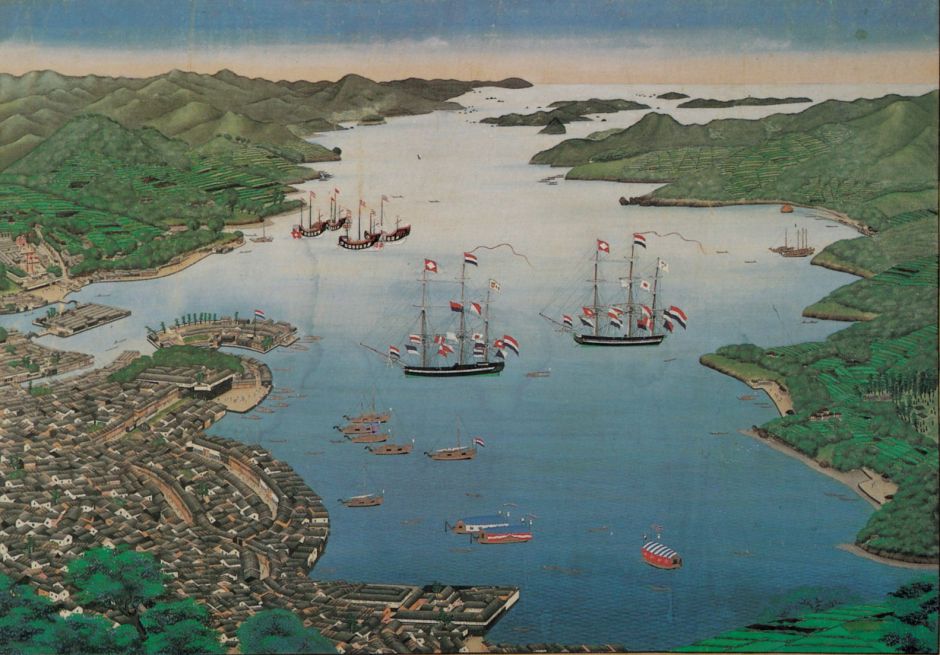
Isolationism continued until a fleet of American ships, under the command of Commodore Matthew C Perry, arrived in Tokyo Bay in 1853. There followed a rapid opening up of trade and cultural exchange, accelerated when the Tokugawa dynasty was overthrown in the brief Boshin War. This marked the beginning of the Meiji period in 1868, with its dramatic reforms and accelerating Westernisation.
Western influence on painting
It is therefore conventional to view the periods of Western influence on Japanese art and painting as:
- prior to 1543, essentially no influence or exchange,
- 1543-1638, considerable influence through Christian missions and trade
- 1638-1853 (Edo), limited influence through the Dutch VOC presence in Nagasaki
- 1868 onwards (Meiji), the official period of Westernisation.
This has to be set against the changes in Western painting, which I summarise very crudely as:
- 1400-1550, the Renaissance, with development of techniques of realism including texture, optical effect and linear perspective, establishment of oil paint as dominant medium, with print-making for mass distribution,
- 1600-1780, Baroque and Rococo, with the refinement of oil painting, portraiture, development of landscape as genre, rich colour and wide tonal range,
- 1780-1860, Neo-classicism, Romanticism, with increasing expression of vision, more painterly styles, plein air, and the rise of landscape,
- 1860-1900, Impressionism, Post-Impressionism, with bright colours, visible marks, dominance of landscape, and a much broader range of subjects and themes.
There is also the curious observation that the influence of Japanese art on nineteenth century painting, by way of Japonisme, was principally through the sale of ukiyo-e prints in Europe, such as those of Hokusai. Ukiyo-e and Hokusai were an early expression of the Western influence on Japanese art, and are quite unlike painting from the masters of the Kanō school, for example. Had the Kanō school been a major influence on European art, then we could have expected very different consequences.
In the next article I will examine the first period of Western influence on Japanese painting, during the years 1543 to 1638.
Further reading and references:
Wikipedia history of Japan
Wikipedia account of the Silk Road
Wikipedia history of painting in Japan
Wikipedia history of painting in China
Wikipedia history of painting in Korea
Elkins J (2010) Chinese Landscape Painting as Western Art History, Hong Kong University Press. ISBN 978 962 209 000 2.
Minoru Harada (1974) Meiji Western Painting, Arts of Japan vol 6, Weatherhill/Shibundo. ISBN 0 8348 2708 5.
Johnson H (2005) Western Influences on Japanese Art. The Akita Ranga Art School and Foreign Books, Hotei Publishing. ISBN 978 9 074 82264 0.
Kang Duk-Hee (2008) Western-Style Painting in Japan. Adaptation and Assimilation, Sophia University Press. ISBN 978 4 324 08032 0.
Screech T (2002) The Lens within the Heart. The Western Scientific Gaze and Popular Imagery in Later Edo Japan, University of Hawai’i Press. ISBN 978 0 824 82594 2.
Screech T (2012) Obtaining Images. Art, Production and Display in Edo Japan, Reaktion Books. ISBN 978 1 86189 814 2.
Vanderstappen HA (2014) The Landscape Painting of China. Musings of a Journeyman, UP Florida. ISBN 978 0 8130 3793 6.

